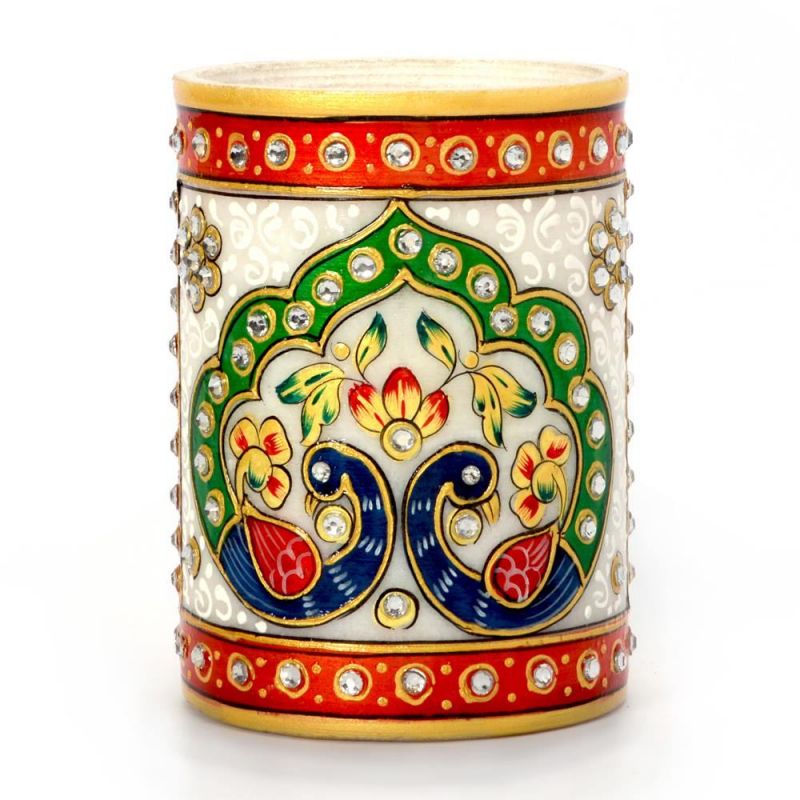Meenakari Art in India
Meenakari is an age old art form of decorating metal with colored enamel. It is reputed for its excellent designs and beautiful colour combinations. The artisans who practice this art form are called ‘Meenakars’. The art form mainly involves making colorful jewellery. Other objects produced using Meenakari include, decorative articles, arm chairs, dining sets, etc.
Main Centers of Meenakari Art in India
Meenakari art form is mainly focused in:
- Silver Meenakari: Nathdwara, Bikaner, Udaipur
- Glass Meenakari: Pratapgarh
- Gulab Meenakari: Varanasi
Other areas include Delhi, Punjab and Lucknow.
Historical Background
The art form has its origin in Persia. It was prevalent in the Mughal palaces. Raja Man Singh of Amber invited skilled Meenakars from the Mughal palace at Lahore to Jaipur. He brought this art to Rajasthan. Now, Jaipur is a renowned centre for Meenakari art form.
Types of Meenakari
The Meenakari mainly involves covering a metal object with coloured enamels. Red, Green and White enamels dominate in this art. The metal used is called ‘chitras’.
An entire object or parts of the object can be covered with enamel. For example, an entire pendant can be covered or a pair of bangles (kara) can be made with three dimensional ‘makara’ elephant/lion/bird heads. The ornaments can be further decorated with precious stones such as Diamonds, Rubies, Emeralds, etc.
Types of Meenakari include:
Ek Rang Khula Mina
This method involves the use of single colour transparent enamel. The engraved area is filled with single enamel leaving gold coloured outlines exposed around figural details.
Panch Rang Mina
This uses enamels of five colors viz. Safed– opaque white, Fakhtai– opaque light blue, Fakhta– a dove, Khula Nila– transparent dark blue and Khula Sabz– transparent green.
Gulabi Mina
It uses a pink enamel derived from Gulab (rose). This form of Meenakari is widely prevalent in Varanasi area. The transparent pink enamel is painted on an opaque white background. When a single transparent enamel is used to fill the ground around an opaque figure, colours of ground such as Lal zamin- transparent red ground, sabz zamin- transparent green ground, nil zamin- transparent blue ground are used. This will provide a contrast and highlights the subject.
The pink enamel is mostly used to paint flowers in the design. Areas other than flowers are painted using ‘champleve’ style. Thus Gulabi Mina is a mixed style of enameling.
Bandh Mina Khaka
This method involves use of opaque cartouche/ outline. Transparent colour is surrounded by opaque enamel cartouche.
Stone carving and enameling
Sometimes, Meenakari art work is combined with Kundans making the articles an amalgamation of stone carving and enameling.
Steps involved in making Meenakari art
- Design is engraved by the ‘gharias’ by making depressions on the Chitras metal.
- After designing, the enameller applies different colours to the engraved design. Colours are applied with the help of brushes.
- Base is first covered with white/pink enamel. After which different colours are applied depending up on their hardness.
- 5 separate enamel applications will be made.
- The article is heated to enhance the richness of colours.
- The heated object is finally polished and cleaned. Hand burnishes are used to cover the exposed metal.
Meenakari art produces various articles ranging from ornaments to pen holders. The metals used include gold, silver and copper. Nowadays, mostly silver and copper is being used. Meenakari Huqqas are the favorites of Meenakari artists. Huqqas of various colors and designs were made during Mughal period. Other forms include, bowl sets, Meenakari roman chair, chowki set, hand casted Meenakari chowki set with white alloy metal, utility box thrones, dining sets, key holders, photo frames, ash trays, pen holders, etc.


